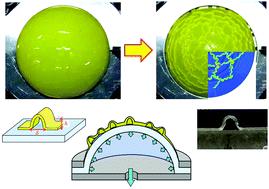当前位置:
X-MOL 学术
›
Soft Matter
›
论文详情
Our official English website, www.x-mol.net, welcomes your feedback! (Note: you will need to create a separate account there.)
Surface buckling delamination patterns of film on soft spherical substrates.
Soft Matter ( IF 3.4 ) Pub Date : 2020-04-29 , DOI: 10.1039/d0sm00122h Kanako Emori 1 , Yusaku Saito 1 , Akio Yonezu 1 , Liangliang Zhu 2 , Xiangbiao Liao 3 , Xi Chen 4
Soft Matter ( IF 3.4 ) Pub Date : 2020-04-29 , DOI: 10.1039/d0sm00122h Kanako Emori 1 , Yusaku Saito 1 , Akio Yonezu 1 , Liangliang Zhu 2 , Xiangbiao Liao 3 , Xi Chen 4
Affiliation

|
This study aims to provide a fundamental understanding of the morphological transition of film buckling-delamination in an elastomeric bilayer spherical shell system. We developed an experimental system in which surface delamination buckles emerge because of biaxial compression of the elastomeric bilayer spherical shell driven by an air-pressured (pneumatic) device. A flat PDMS plate was first isotropically expanded and shaped into a hemisphere by air pressure. Subsequently, the hemisphere substrate was covered with a thin PDMS film. By releasing the air pressure, the substrate contracts and the outer film surface were subjected to biaxial compression; this resulted in various surface patterns of film buckling-delamination. It was found that the surface morphology transitions from initial delamination sites and that the buckles propagate on the entire surface of the sphere. This pattern formation is dependent on the surface strain distribution, i.e., radial strain and circumferential strain. In order to control the surface pattern, we systematically changed the material and system parameters such as film thickness, Young's modulus, and interfacial adhesion condition. In addition, finite element (FEM) computation was carried out to simulate the surface pattern and to elucidate the mechanism of buckling-delamination morphological transition.
中文翻译:

软球形基材上薄膜的表面屈曲分层图案。
本研究旨在提供对弹性双层球壳系统中薄膜屈曲-分层的形态学转变的基本理解。我们开发了一个实验系统,其中由于气压(气动)装置驱动的弹性体双层球形壳体的双轴压缩,因此出现了表面分层弯曲。首先使平板PDMS板各向同性膨胀,并通过气压使其成形为半球。随后,用PDMS薄膜覆盖半球基板。通过释放气压,使基板收缩,并且使外膜表面进行双轴压缩。这导致了薄膜屈曲-分层的各种表面图案。已经发现,表面形态从最初的分层位置过渡,并且弯曲在球的整个表面上传播。该图案的形成取决于表面应变分布,即径向应变和周向应变。为了控制表面图案,我们系统地更改了材料和系统参数,例如膜厚度,杨氏模量和界面附着条件。此外,还进行了有限元(FEM)计算,以模拟表面图案并阐明屈曲-分层形态转变的机理。我们系统地更改了材料和系统参数,例如膜厚度,杨氏模量和界面粘附条件。此外,还进行了有限元(FEM)计算,以模拟表面图案并阐明屈曲-分层形态转变的机理。我们系统地更改了材料和系统参数,例如膜厚度,杨氏模量和界面粘附条件。此外,还进行了有限元计算,以模拟表面图案并阐明屈曲-分层形态转变的机理。
更新日期:2020-03-26
中文翻译:

软球形基材上薄膜的表面屈曲分层图案。
本研究旨在提供对弹性双层球壳系统中薄膜屈曲-分层的形态学转变的基本理解。我们开发了一个实验系统,其中由于气压(气动)装置驱动的弹性体双层球形壳体的双轴压缩,因此出现了表面分层弯曲。首先使平板PDMS板各向同性膨胀,并通过气压使其成形为半球。随后,用PDMS薄膜覆盖半球基板。通过释放气压,使基板收缩,并且使外膜表面进行双轴压缩。这导致了薄膜屈曲-分层的各种表面图案。已经发现,表面形态从最初的分层位置过渡,并且弯曲在球的整个表面上传播。该图案的形成取决于表面应变分布,即径向应变和周向应变。为了控制表面图案,我们系统地更改了材料和系统参数,例如膜厚度,杨氏模量和界面附着条件。此外,还进行了有限元(FEM)计算,以模拟表面图案并阐明屈曲-分层形态转变的机理。我们系统地更改了材料和系统参数,例如膜厚度,杨氏模量和界面粘附条件。此外,还进行了有限元(FEM)计算,以模拟表面图案并阐明屈曲-分层形态转变的机理。我们系统地更改了材料和系统参数,例如膜厚度,杨氏模量和界面粘附条件。此外,还进行了有限元计算,以模拟表面图案并阐明屈曲-分层形态转变的机理。



























 京公网安备 11010802027423号
京公网安备 11010802027423号